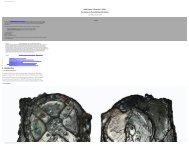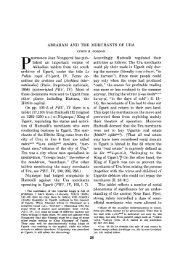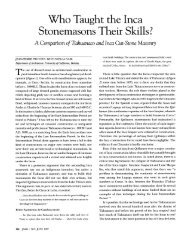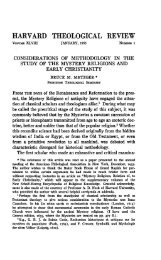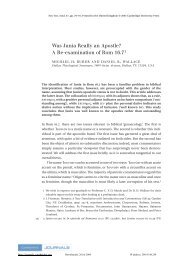Paul's Argument from Nature for the Veil in - Michael S. Heiser
Paul's Argument from Nature for the Veil in - Michael S. Heiser
Paul's Argument from Nature for the Veil in - Michael S. Heiser
You also want an ePaper? Increase the reach of your titles
YUMPU automatically turns print PDFs into web optimized ePapers that Google loves.
82<br />
Journal of Biblical Literature<br />
hygienic purpose by remov<strong>in</strong>g <strong>the</strong> pubic hair and destroy<strong>in</strong>g its power to draw<br />
reproductive fluid to <strong>the</strong> genital area. In contrast to pluck<strong>in</strong>g <strong>the</strong> hair, s<strong>in</strong>ge<strong>in</strong>g<br />
seals <strong>the</strong> open<strong>in</strong>g <strong>in</strong> <strong>the</strong> hair and more effectively removes <strong>the</strong> suction power of<br />
<strong>the</strong> pubes. Thus, depilation of <strong>the</strong> pubes and especially depilation by s<strong>in</strong>ge<strong>in</strong>g<br />
enhances female fertility by remov<strong>in</strong>g <strong>the</strong> pubic counter<strong>for</strong>ce to <strong>the</strong> upward<br />
draw of <strong>the</strong> hair on <strong>the</strong> head, and postmenopausal women cease or should<br />
cease depilat<strong>in</strong>g <strong>the</strong> pubes (Martial, Epigram 10.90).<br />
F<strong>in</strong>ally, this conception of hair expla<strong>in</strong>s why prepubescent girls were not<br />
required to wear <strong>the</strong> veil whereas adult women were. Be<strong>for</strong>e puberty, a girl’s<br />
hair is not a function<strong>in</strong>g genital and does not differ <strong>from</strong> a boy’s hair. After<br />
puberty, however, this situation changes. Tertullian draws an analogy between<br />
prepubescent children and Adam and Eve, who were naked be<strong>for</strong>e <strong>the</strong>y<br />
became aware of genital differentiation. Afterwards though, Tertullian notes,<br />
“They each marked <strong>the</strong> <strong>in</strong>telligence of <strong>the</strong>ir own sex by a cover<strong>in</strong>g” (Virg. 11<br />
[ANF 4:34]). Not<strong>in</strong>g <strong>the</strong> growth of <strong>the</strong> pubes to cover <strong>the</strong> female pudendum,<br />
Tertullian exhorts, “Let her whose lower parts are not bare have her upper likewise<br />
covered” (Virg. 12 [ANF 4:35]). Tertullian’s analogy and exhortation presume<br />
that hair becomes a function<strong>in</strong>g part of a young woman’s genitalia at<br />
puberty similar to <strong>the</strong> way testicles beg<strong>in</strong> function<strong>in</strong>g at puberty as part of <strong>the</strong><br />
male genitalia <strong>in</strong> facilitat<strong>in</strong>g <strong>the</strong> dissem<strong>in</strong>ation of semen. 30 Prepubescent girls,<br />
<strong>the</strong>re<strong>for</strong>e, need not cover <strong>the</strong>ir hair, but pubescent young women should, and<br />
Tertullian recommends that <strong>the</strong> extent of <strong>the</strong> veil be “co-extensive with <strong>the</strong><br />
space covered by <strong>the</strong> hair when unbound” (Virg. 17 [ANF 4:37]).<br />
The mascul<strong>in</strong>e functional counterpart to long fem<strong>in</strong><strong>in</strong>e hair, <strong>the</strong>n, is <strong>the</strong><br />
testicle. 31 Aristotle calls <strong>the</strong> male testicles weights that keep <strong>the</strong> sem<strong>in</strong>al chan-<br />
30 In contrast to pubescent girls, who began to cover <strong>the</strong>ir hair, pubescent boys cut <strong>the</strong>ir hair<br />
as a rite of passage. In his life of Theseus, Plutarch describes a custom at Delphi of youths’ sacrific<strong>in</strong>g<br />
<strong>the</strong>ir hair when <strong>the</strong>y reach puberty (Thes. 5.1; Bernadotte Perr<strong>in</strong>, Plutarch’s Lives with an<br />
English Translation by Bernadotte Perr<strong>in</strong> [LCL; 11 vols.; Cambridge, MA: Harvard University<br />
Press, 1967], 1.11). He writes, “S<strong>in</strong>ce it was still a custom at that time <strong>for</strong> youth who were com<strong>in</strong>g of<br />
age to go to Delphi and sacrifice some of <strong>the</strong>ir hair to <strong>the</strong> god, Theseus went to Delphi <strong>for</strong> this purpose.”<br />
The custom evidently <strong>in</strong>volved <strong>the</strong> shav<strong>in</strong>g of <strong>the</strong> head, because Theseus only shaved <strong>the</strong><br />
front part of his head, and his action was considered so unusual that this hairstyle or tonsure<br />
became known as Theseis. The physiological reason Theseus shaved only <strong>the</strong> front part of his head<br />
is that <strong>the</strong> bra<strong>in</strong>, which produces and stores <strong>the</strong> semen, is located <strong>the</strong>re. See Aristotle, Gen. an.<br />
783b.38–784a.4). This rite probably had several mean<strong>in</strong>gs. From a physiological perspective, however,<br />
<strong>the</strong> hair that had attracted <strong>the</strong> reproductive fluid upward be<strong>for</strong>e puberty is shaved as <strong>the</strong> testicles<br />
develop and beg<strong>in</strong> to attract this fluid downward <strong>in</strong> pubescent boys.<br />
31 The Greek term o[rci" refers both to male testicles and female ovaries. However, ancient<br />
medical science did not ascribe a correspond<strong>in</strong>g reproductive function to testicles and ovaries. The<br />
testicles served as receptacles <strong>for</strong> reproductive fluid and per<strong>for</strong>med <strong>the</strong> f<strong>in</strong>al froth<strong>in</strong>g to transmit<br />
<strong>the</strong> heat that carried <strong>the</strong> <strong>for</strong>m of <strong>the</strong> <strong>in</strong>dividual. The Hippocratics, however, do not ascribe such a<br />
function to ovaries. Their flat shape was not conducive to attract<strong>in</strong>g reproductive fluid. Dean-Jones



